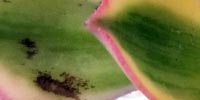Aeonium (eh-OH-nee-um) are a wild and whimsical group of succulents from the subtropical Canary Islands. With pinwheel rosettes perched atop long, undulating stems they make a striking subshrub in Mediterranean climates and a real stunner of a window sill plant everywhere else. Whether kept short and tidy with pruning or given space to branch and sprawl, these showy beauties are sure to captivate.
APPEARANCE
- Colors: Aeonium display a wide range of colors including white, yellow, lime green, red, and a purple so dark it looks black. These tones appear in a variety of patterns from solid to stripped to ombré gradients.
- Form: As the rosette grows from its center and sheds lower leaves, the stout stems elongate (up to 5.0' tall for some types!). The wide rosettes and curving stems marked by leaf scars give a palm tree-like appearance and reveal why some people refer to these plants as "Tree Houseleeks". The stems branch freely and can form prolific clusters.
- Foliage: The leaves are rubbery but thin for a succulent and spiral out like a pinwheel. Each leaf is lined with a margin of fine cilia. Depending on the variety, the flat, open rosettes can grow from 2.0" to 2.0' in diameter.
- Flowers: Aeonium flowers are giant, impressive spikes that bolt up from the center of a rosette and explode in a conical cluster of yellow, pink, or white blossoms. Most varieties are monocarpic, meaning they will grow for several years, bloom, go to seed, then die, leaving all the unbloomed branches to carry on.
CARE
- Light: Darker, reddish varieties are adapted to life on exposed cliffsides and need plenty of bright sunshine to thrive. Green varieties come from understory habitats and can tolerate dappled shade if they are outdoors. Indoor growing is possible if plants are kept on a sunny window sill or under a grow light.
- Soil: As with other succulents, look for a soil that is well-draining. You can find cactus/succulent soil at most garden centers or amend your soil with mineral grit, e.g. coarse sand, pumice, or perlite, to improve drainage. If planting in a container, try to select pots with drainage holes.
- Water: Aeonium are accustomed to mild, coastal climates and can tolerate slightly more frequent watering than most succulents. They are adapted to dry summers and winter rainy seasons. In the fall through spring growing season, water deeply when the soil is dry. Reduce watering frequency during summer dormancy to prevent rot.
- Hardiness: This genus is not cold hardy and should be brought indoors if there is a chance of hard frost to overwinter on a sunny window sill or under a grow light.
- Propagation: Aeonium re-root readily from stem cuttings and regular pruning or "beheadings" allow those who don't like the look of sprawling stems to keep their plants a bit shorter. Use a clean, sharp knife to cut the stem 1.0" to 2.0" below the rosette then replant the cutting in fresh, well-draining soil. (Full Guide to Succulent Cuttings)
NOTES FROM THE NURSERY
Aeonium rosettes are very sensitive and regularly have SHIPPING ISSUES including bruising, abrasions, and curled leaves. We package as carefully as possible but things can go wrong in transit. Therefore, this plant is not recommended for retail shelves or display purposes. The brown marks will disappear gradually as the plant grows and replaces the bruised leaves.


When first described by 18th century botanist Carl Linnaeus, these plants were named Sempervivum arboreum. While they've since moved on taxonomically, Aeonium are somewhat of a tropical, tree-like cousin of the hardy, northern Sempervivum (Hens & Chicks). The current name of the genus comes from the Greek aionion, or "eternal", in reference to the plants' resilient nature and longevity.
The broad variety of forms, colors, and sizes within this genus are a product of its mountainous, island origins. As different populations became geographically isolated, they diverged down different evolutionary paths. The result is the rich diversity of species we see today, which is magnified by the large assortment of cultivated varieties produced by hybridizers.
A word on dormancy. Aeonium differ from many of our other succulents in that they grow through the winter and go dormant in summer. This is a nod to their native climate, where winters are mild but rainy and summers are too hot and dry to support growth. Accommodate their natural patterns by allowing them to dry out during their summer dormancy. The rosettes will shrink and close up when dormant, but reopen as they rehydrate in the fall.
"One thing I love about succulents, and aeoniums in particular, is that no flowers are needed to put on a great show. Yet when they do bloom, the flowers are spectacular." (Debra Lee Baldwin, Succulents Simplified).
READ MORE